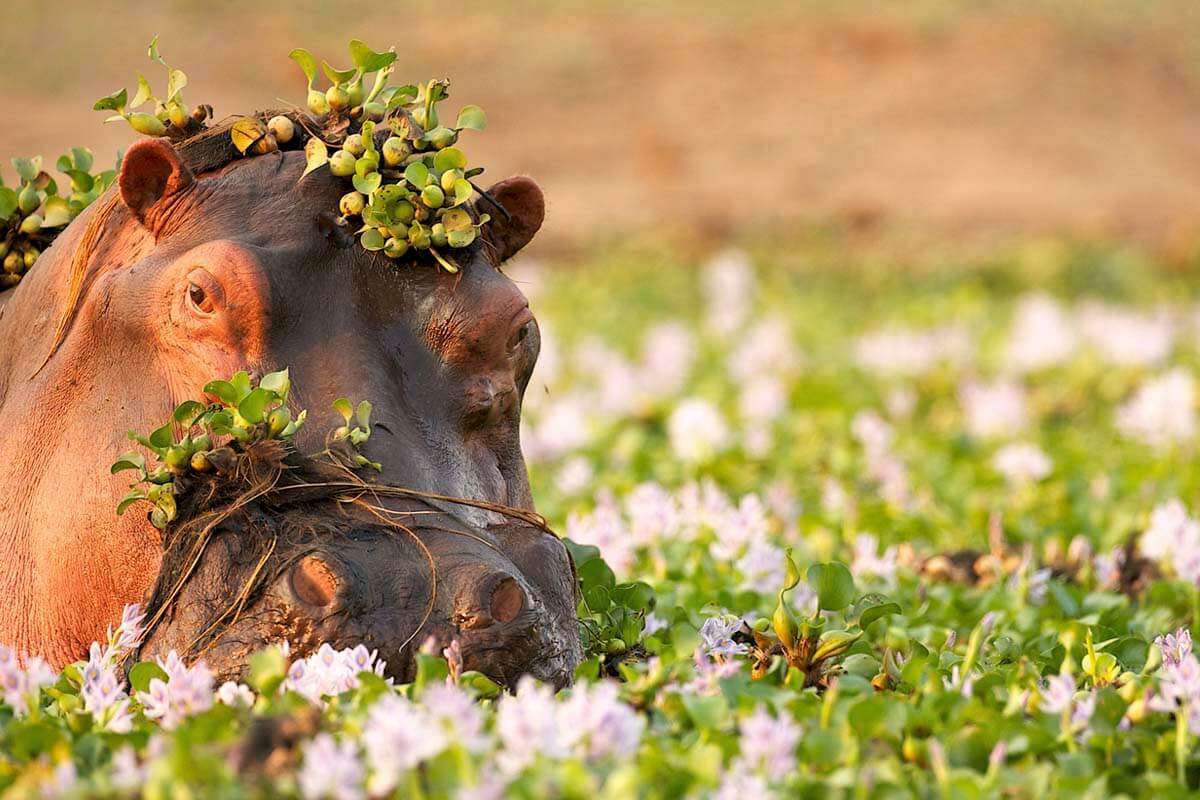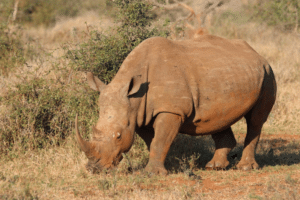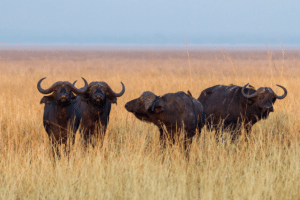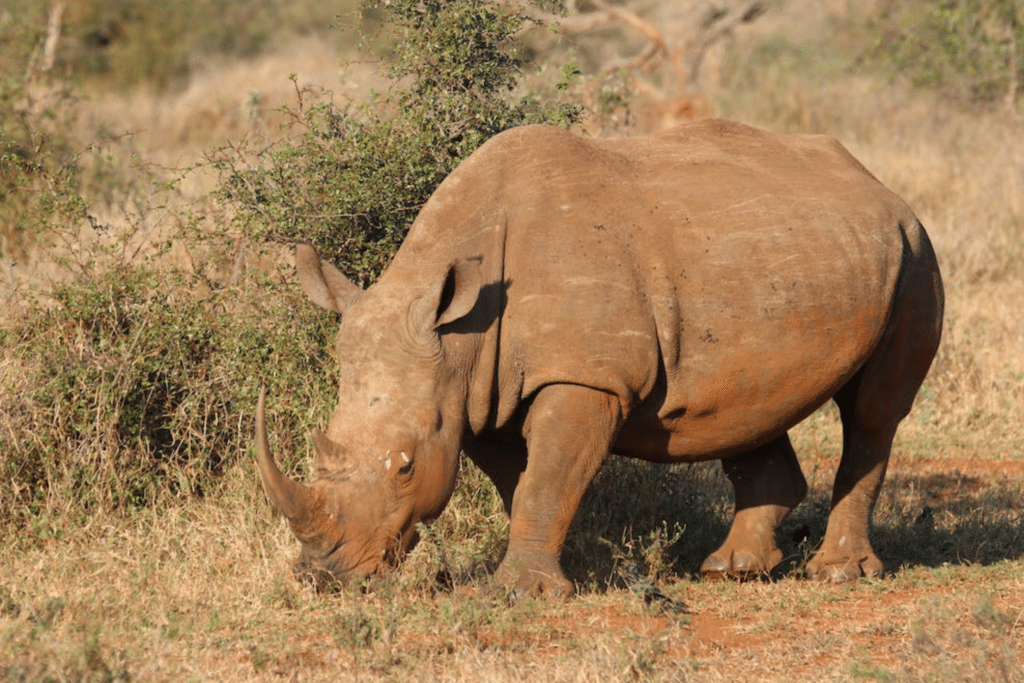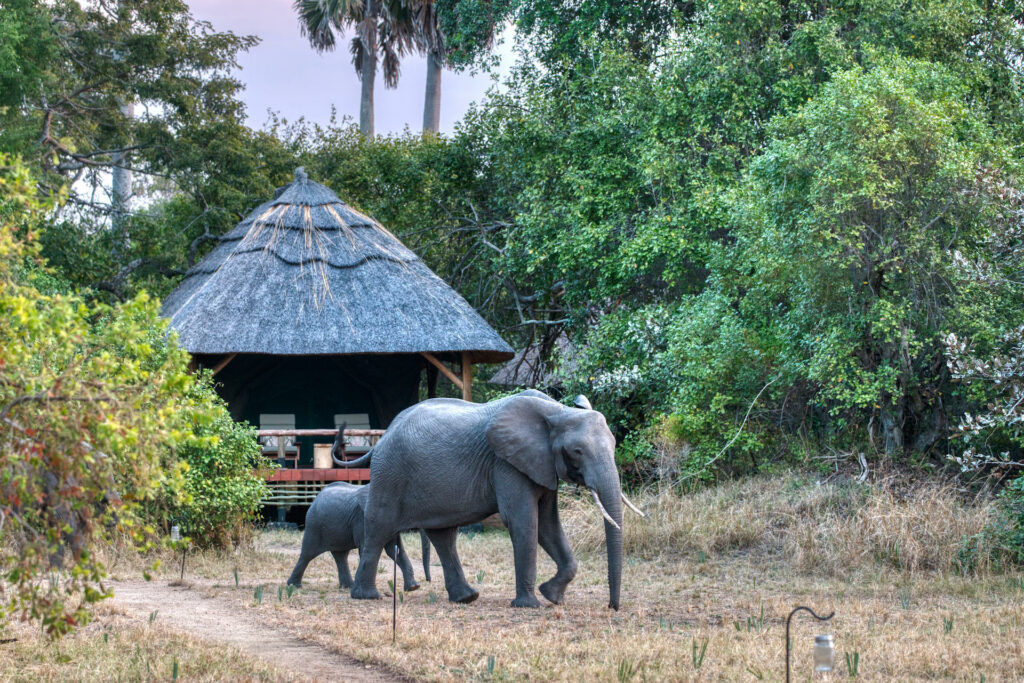The Hippopotamus is like a giant armored vehicle in Africa. It weighs two tons and is the third-largest land mammal globally (after elephants and rhinos). These hefty creatures, known for their love of water, can stretch as long as a grown giraffe and tip the scales at more than double the weight of an average car.
Often spotted relaxing in muddy pools, hippos may look cute but are not creatures to provoke. The name “Hippopotamus” originates from Greek, meaning “water horse,” but these creatures are far from resembling horses.
They’re some of the most peculiar and dangerous animals you’ll encounter on a safari. They spend up to sixteen hours a day partially submerged in rivers, often seen in groups called “bloats,” consisting of 10-20 hippos.
In this guide, we’ve gathered the latest and most essential information about hippo bloats for your safari adventure. So grab your raincoat (you’ll soon understand why) and prepare to be amazed by fascinating hippo facts that will impress your fellow safari-goers.
Introducing hippopotamus: The barrel-bodied submarines of the Serengeti

– Species name: Hippopotamus amphibious. Two species: The common Hippopotamus (what you’ll experience on safari) and the Pygmy Hippopotamus, an endangered species native to the forests and swamps of Western Africa.
– Hippopotamus Average Lifespan: Up to 40-50 years.
Hippopotamus Size: The average adult is 11 feet (3.5 meters) long, 5 feet tall (1.5 meters), and weighs 3,000-7,000 pounds.
– Hippopotamus Range: Historically widespread in North Africa and Europe. Now, only in select parts of Africa.
– Hippopotamus Estimated Population: 125,000 – 150,000 worldwide. 20,000 – 30,000 in Tanzania. Densest population in Tanzania: Katavi National Park, Serengeti National Park.
5 facts about the hippopotamus you’ve never heard of before

1. They can hold their breath for 5 Minutes
What you might notice about hippos is that most of their essential parts—ears, nose, and eyes—are on the top of their massive heads. This allows them to remain half-submerged in water for most of the day.
To be sure, hippos go beneath the surface using built-in goggles, a transparent film that covers their eyes so they can see while moving. They can’t swim, however. Hippos sink. Instead, they will walk or run along river bottoms. Amazing. (Source)
2. Hippos are related to whales
Due to their smooth skin and large stomachs, some scientists once thought hippos were related to pigs. But that’s far from the truth.
Hippopotamus ancestors connect more closely with whales and dolphins than with other animals. Although there’s still some debate, the prevailing theory suggests that hippos split from these marine ancestors around 55 million years ago.
Despite their seemingly docile appearance, hippos are among Africa’s most dangerous animals, particularly males, who fiercely protect their territory and females and can be extremely aggressive when provoked. Even female hippos can be highly territorial and aggressive, especially when protecting their young. (Source)
3. Pablo Escobar, a Colombian drug lord, owned hippos
Escobar, once the world’s most wanted kingpin in the South American drug trade, was so rich that he started his zoo. Escobar imported, among other species, five hippos, which he owned on his ranch until he died in 1993.
Since then, the zoo has been unkempt, and these hippos have escaped and begun to procreate. Today, over 50 hippos are running wild in Colombia—the largest population outside Africa—and it’s become a problem (Source).
4. Baby hippos are the cutest (and the hugest)
If you’re having a bad day, conduct a web search for “baby hippos,” your mood will undoubtedly shift. When hippopotamus infants arrive through the birth canal at 100 pounds, they are born underwater and must learn to swim immediately.
Quickly, they learn how to draw milk from their mother while underwater. Now, that’s multitasking. (Source) Click here to see the video
5 – Hippo poo plays a vital role
As herbivores, hippos eat 80-100 pounds of grass in a single meal. Because they sit in rivers and lakes all day, their dung naturally cycles into waterways, benefiting many species (a phenomenon called “coprophagia”).
Rich in nutrients, hippo dung is now a necessary ingredient to the health of many African rivers. While we’re on the topic, their excrement is also used to attract mates. How exactly? Males will fling the stuff with the propeller of their tail to impress a female. The further the fling, the better the chances of scoring. No joke. ( Source)
Hippo Communication and Social Structure
Hippopotamuses, often called “river horses,” exhibit complex communication and social structures within their groups. Dominated by a dominant male hippo, a bull, these social units typically consist of several females and their offspring. Male hippos establish their dominance through vocalizations, posturing, and physical displays, ensuring their status within the group.
Female hippos play a crucial role in the social dynamics, forming strong bonds with other members and contributing to the overall cohesion of the herd. Meanwhile, pygmy hippos, a smaller and more elusive species, exhibit similar social behaviors but tend to be more solitary. Despite their docile appearance, hippos are among the world’s most dangerous animals, capable of inflicting fatal injuries on humans and other animals.
They are primarily nocturnal animals, spending their days submerged in water to avoid the heat and emerge at night to graze on grasses. However, despite their formidable presence, hippos are vulnerable to habitat loss, poaching, and human conflicts.
Hippo Habitat and Range:
Hippos are semi-aquatic mammals primarily found in sub-Saharan Africa, inhabiting rivers, lakes, and swamps. They prefer areas with shallow water and nearby grasslands for grazing, making habitats like the Nile River and its tributaries and freshwater lakes in East Africa ideal for survival.
Despite their bulk, hippos are surprisingly agile in water, where they spend most of their time keeping cool and avoiding the harsh African sun. These water bodies provide essential hydration, protection from predators, and ample grazing opportunities along the banks.
Hippo Reproduction and Parental Care
Hippos have a unique way of reproducing, often mating in the water. Once pregnant, female hippos carry their babies for about eight months before giving birth.
They do this mostly in shallow water or on riverbanks. Mothers take great care of their calves, keeping them safe and giving them lots of attention.
Calves are born precocial, meaning they are relatively mature and can stand and walk shortly after birth. Despite this, they remain dependent on their mothers for nursing and protection for up to a year or more, gradually integrating into the herd’s social structure.
Hippo Diet and Feeding Habits
Hippos are herbivores, primarily grazing on grasses and aquatic vegetation. Despite their vast size, they are selective feeders, preferring tender shoots and leaves over stricter vegetation. Fruits supplement their diet, and occasionally crops when available.
Despite spending most of the day submerged in water, hippos venture onto land at night to graze. They consume large quantities of vegetation to meet their nutritional needs. Their unique jaw structure and large teeth allow them to process rigid plant material efficiently.
Bottom line?
Here’s a good rule of thumb for any safari: visit watering holes. Rivers, lakes, and ponds attract significant wildlife, and your experienced Easy Travel guide will know the best spots to witness such water-loving creatures as crocodiles, wildebeest crossings, birds, and hippos.
Hippos are descendants of whales. They love to roll and play in shallow water, and their offspring are the most adorable things on Earth. Contact Easy Travel today, and let’s plan your visit to Tanzania.
Getting you there?
With over 30 years of experience, Easy Travel is an award-winning tour operator with extensive knowledge of the local wildlife in Tanzania. Our guides have decades of experience and know where to go, when to go, and how best to see these animals (and many more!).
Click here for more info. Get up close and personal on our Comfort Wildlife Encounters tour. Alternatively, get in touch and build your lifetime journey.
Frequently Asked Questions (FAQs)
Do hippos make good pets?
While charismatic and intriguing, Hippos are unequivocally unsuitable as pets due to their wild nature and unique needs. Their large size and territorial instincts make them challenging to manage domestically, posing potential risks to humans and other pets.
Moreover, hippos have specific dietary requirements, primarily grasses and aquatic vegetation, which are challenging to replicate outside their natural habitat. Attempting to domesticate hippos also disregards their intrinsic need for vast water bodies to thrive, further highlighting the impracticality and potential dangers of keeping them as pets.
Are hippos related to pigs?
While hippos may share some physical features with pigs, they belong to the Hippopotamidae family, which places them in a different evolutionary lineage. Their closest relatives are cetaceans, including whales and dolphins, rather than pigs.
Around 55 million years ago, hippos diverged from their common ancestor with whales and dolphins, adapting to a semi-aquatic lifestyle that defines their unique characteristics and behaviors in today’s ecosystems. This evolutionary journey explains their remarkable adaptations to life in and around water, contrasting with their terrestrial relatives in the animal kingdom.
How do hippos communicate with each other?
Despite their imposing size and appearance, hippos possess a complex communication system comprising various vocalizations and physical gestures. They convey messages related to dominance, aggression, and social interactions through grunts, honks, and wheezes.
Additionally, body language, including ear flicks and yawning, serves as visual cues to establish hierarchy and maintain social cohesion within hippo groups. This intricate communication network allows hippos to navigate their social dynamics effectively while inhabiting their natural habitats.
Are hippos endangered?
Due to habitat loss, poaching, and increasing conflicts with humans, hippos are now classified as vulnerable. Conservation organizations and governments implement various strategies to safeguard their populations and habitats.
These efforts include establishing protected areas, such as national parks and wildlife reserves, where hippos can thrive without human interference. Additionally, community-based conservation initiatives promote coexistence between local communities and hippos, aiming to reduce conflicts and protect critical habitats.
Through these collaborative efforts, there is hope for the long-term survival of hippos in their natural environments.
Do hippos live in groups?
Hippos reside in social groups, often called pods or herds, which typically comprise several females, their young, and a dominant male. These group structures offer various benefits, including increased protection against predators and support for social interactions within the community.
Within these pods, interactions such as mating, nurturing offspring, and communal defense against threats are common occurrences, fostering cooperation and mutual reliance among members. The dominant male plays a vital role in maintaining order within the group, asserting its dominance, and ensuring the safety and well-being of its members.
Can hippos swim?
Hippos possess remarkable aquatic abilities. They excel as swimmers and spend considerable time submerged in water to regulate their body temperature and avoid the sun’s scorching heat. Their streamlined bodies, webbed feet, and dense bones facilitate effortless movement through the water, enabling them to navigate with agility and grace.
Despite their bulky appearance, hippos are surprisingly agile in aquatic environments. They utilize their unique adaptations to glide gracefully beneath the surface and explore their watery habitats easily. This aquatic prowess is essential for their survival, allowing them to thrive in their semi-aquatic lifestyles and access vital resources in their freshwater habitats.
How fast can hippos run?
Despite their hefty build, hippos exhibit astonishing agility on land, reaching up to 30 kilometers per hour (18.6 miles per hour). With their immense size and powerful jaws, this remarkable swiftness renders them one of the most formidable and dangerous animals on the African continent.
Despite their herbivorous diet, hippos are fiercely territorial and will aggressively defend their territories from perceived threats, including humans and other animals. Their impressive speed and strength are formidable defense mechanisms, allowing them to evade predators and assert dominance in their natural habitats.
Do hippos eat meat?
Indeed, hippos are strictly herbivorous animals, subsisting mainly on a diet of grasses and aquatic vegetation found in their natural habitats. While they may occasionally ingest fruits or crops, their direct source of nutrition comes from grazing on grasses along riverbanks and in shallow waters.
Despite their massive size, hippos are efficient grazers, consuming large quantities of low-nutrient grasses to sustain their energy levels. Unlike carnivorous predators, hippos do not actively hunt or scavenge for meat, relying instead on plant-based foods to meet their dietary requirements.
What is a hippo’s lifespan?
In their natural habitat, hippos generally have a lifespan of approximately 40 to 50 years, although this can vary due to factors like habitat quality, availability of resources, and predation risk. In captivity, where they are sheltered from many environmental pressures and receive specialized care, hippos have been known to live even longer, with some individuals reaching up to 60 years of age or more.
However, despite potentially longer lifespans in captivity, these animals still face various health challenges and stressors that can impact their overall well-being and longevity. As with many species, ensuring the conservation of wild habitats and implementing effective management strategies are crucial for supporting healthy hippo populations and promoting their long-term survival.
Are hippos nocturnal?
While hippos are primarily nocturnal, they can also be active during the day, especially when they need to forage for food or find water sources. They exhibit crepuscular behavior, meaning they are most active during dawn and dusk. Still, their activity levels can vary depending on factors like temperature, habitat disturbance, and the availability of resources.
In areas where human activities disrupt their natural behavior or alter their habitat, hippos may adjust their activity patterns to avoid disturbances or capitalize on resources when they are less disturbed. Additionally, during periods of extreme heat, hippos may retreat to water bodies to cool off, regardless of the time of day.
Are there different species of hippos?
There are two species of hippos: the common Hippopotamus (Hippopotamus amphibius) and the pygmy Hippopotamus (Choeropsis liberiensis). The common Hippopotamus is the largest of the two species throughout sub-Saharan Africa. In contrast, the pygmy Hippopotamus is smaller and confined to forested areas in West Africa.
How do hippos protect themselves?
Hippos are among the most dangerous animals in Africa, and they rely on their large size, formidable tusks, and aggressive behavior to defend themselves and their territories. They charge at perceived threats, using their powerful jaws and sharp teeth to deter predators and rivals.
Do hippos hibernate?
No, hippos do not hibernate. They stay active throughout the year, even in colder months, relying on their thick skin and water to regulate their body temperature. However, they may become less active during extreme heat or drought, seeking refuge in water to stay cool and hydrated.
Can hippos hold their breath underwater?
Yes, hippos can hold their breath for several minutes while submerged in water, typically surfacing every few minutes to breathe. Their nostrils, located on the top of their heads, close automatically when submerged, allowing them to stay underwater for extended periods without drowning.
Do hippos have any natural predators?
While adult hippos have few natural predators due to their size and aggression, young calves may fall prey to crocodiles, lions, and hyenas. Crocodiles are the most significant threat to hippo calves, lurking in rivers and water bodies where hippos often give birth and raise their young.













